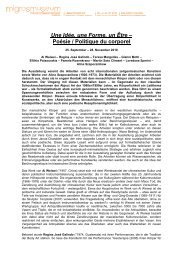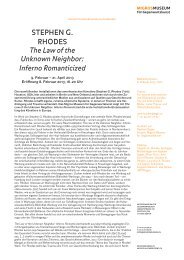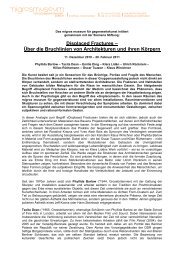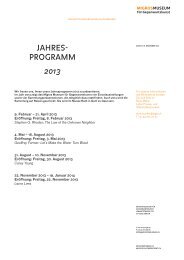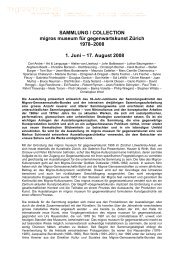Heidi Bucher - Mother of Pearl - Migros Museum
Heidi Bucher - Mother of Pearl - Migros Museum
Heidi Bucher - Mother of Pearl - Migros Museum
Create successful ePaper yourself
Turn your PDF publications into a flip-book with our unique Google optimized e-Paper software.
<strong>Heidi</strong> <strong>Bucher</strong><br />
(1926-1993)<br />
-<br />
<strong>Mother</strong> <strong>of</strong> <strong>Pearl</strong><br />
Retrospective<br />
November 13, 2004 – January 6, 2005<br />
The exhibition “<strong>Heidi</strong> <strong>Bucher</strong>: <strong>Mother</strong> <strong>of</strong> <strong>Pearl</strong>” at the migros museum für gegenwartskunst is<br />
the first large-scale retrospective <strong>of</strong> <strong>Bucher</strong>s work since her death. During the 1970s and<br />
1980s, <strong>Heidi</strong> <strong>Bucher</strong> (1926-1993) became known for the latex “layerings” that she crafted for<br />
spatial architectures. As well as these layers or “skins”, which represent the core <strong>of</strong> the<br />
exhibition, the show includes drawings, sculptures and a video performance, together with the<br />
film “spaces are shells, are skins”, by George Reinhart.<br />
“I see the villa for the first time from the terrace. Now, I enter the house. I look at the walls, the doors, the<br />
windows, the ceilings and the floors. I touch them. I peruse them for a long time. I have to get nearer to<br />
everything. I arrive, we arrive at the right time, with gauze. We cover the walls and listen. We peruse the<br />
surfaces and layer them. We cover and uncover. The lived and the past are entangled with the cloth, and<br />
linger there. We slowly loosen the rubber layering, the skin, tugging the yesterday into today.” <strong>Heidi</strong> <strong>Bucher</strong><br />
(1926 – 1993)<br />
<strong>Heidi</strong> <strong>Bucher</strong> was born 1926 in Winterthur (Switzerland) and was brought up in a late 19th century<br />
bourgeois villa. After her school education in Teufen, she studied at the Zurich Kunstgewerbeschule<br />
(Academy for Applied Arts) from 1942 until 1946; among her instructors were Johannes Itten and Max<br />
Bill. After graduating, <strong>Bucher</strong> focused mainly on linear drawings and collages, working as an illustrator<br />
for the Zurich daily Tages-Anzeiger. In the 1950s, she held exhibitions <strong>of</strong> drawings and silk collages.<br />
During the 1960s, with the collapse <strong>of</strong> the traditional definitions <strong>of</strong> “painting” and “sculpture”, many<br />
artists, including Richard Serra, Louise Bourgeois and Bruce Nauman, embarked on a search for new<br />
means <strong>of</strong> expression, and began experimenting with new materials such as natural latex. Latex played<br />
an essential role in Eva Hesse’s work (1936-1970), as it later did in <strong>Heidi</strong> <strong>Bucher</strong>’s.<br />
In 1969, <strong>Heidi</strong> <strong>Bucher</strong> lived in Canada for a year, before moving to the West Coast <strong>of</strong> the USA until<br />
1972. In Los Angeles, she produced, together with her former husband Carl <strong>Bucher</strong>, her large-scale<br />
foam sculptures Body Shells (1972) and Landings to wear (1972). The portable sculptures enclose<br />
and separate the human subject from its environment, <strong>of</strong>fering a retreat into privacy; their alienating<br />
form is reminiscent <strong>of</strong> the futuristic fashion <strong>of</strong> the time. <strong>Bucher</strong>’s hybrid “clothing sculptures” were<br />
featured on the cover <strong>of</strong> Harper’s Bazaar. In 1974, back in Zurich, <strong>Heidi</strong> <strong>Bucher</strong> began to embalm<br />
clothes, blankets, cushions and other objects with “rubber milk”, and to assemble them into simple<br />
arrangements. The objects all pertained to the private sphere. Her work became a hunt for clues to<br />
her proper existence, an approach that was shared by a number <strong>of</strong> artists at the time. <strong>Bucher</strong> began to<br />
examine her own life like a historian. Her layerings are thus closely linked to the “clothing-reliefs”, and<br />
were initiated in the same year, 1974. From 1974 until 1977, <strong>Bucher</strong> lived and worked in a former<br />
butcher’s shop. Her atelier was situated on the spacious lower floor, which she called Borg. This was<br />
where the first spatial layerings took place. With the Herrenzimmer (“Men’s Room”, 1977/1978)<br />
<strong>Bucher</strong> returned to her childhood home, the 19th century Winterthur villa. She coated the wood<br />
panelling <strong>of</strong> the walls and floors with viscous latex. Once this had hardened, she tore <strong>of</strong>f the textilelatex<br />
skins, and embalmed them with mother-<strong>of</strong>-pearl pigment. As she rubbed in the pigment, the<br />
skins acquired a shimmering, iridescent surface, and also a new “inner life”.<br />
In 1991, <strong>Heidi</strong> <strong>Bucher</strong> began layering the Villa Bleuler in Zurich. The villa, built in the 19th century<br />
Italian new-Renaissance style, houses the Swiss Institute for Art Research. In collaboration with the<br />
Institute, <strong>Bucher</strong>, fascinated by the walls, floors, ceilings, oven flaps and other items, layered the entire<br />
house. In 1993, <strong>Heidi</strong> <strong>Bucher</strong> died <strong>of</strong> cancer in Brunnen (Switzerland).
!INFORMATION!<br />
An exhibition catalogue with essays by Heike Munder, Philip Ursprung and an epilogue by Mayo and<br />
Indigo <strong>Bucher</strong> will be published in January by JRP/Ringier. A DVD with the film “Räume sind Hüllen,<br />
sind Häute” by George Reinhart will be released by ArtAdventures.<br />
Guided tours:<br />
Sundays, November 21 & 28, December 12, January 9, 3pm<br />
Thursday, December 2, 6pm<br />
A guided family tour at the migros museum für gegenwartskunst, with Brigit Meier, is planned for<br />
Sunday, November 21, at 3pm.<br />
Opening hours:<br />
Tues / Wed / Fri 12 - 6pm, Thurs 12 – 8pm, Sat / Sun 11am – 5pm<br />
The museum will remain closed on December 25, 26 & 31, as well as on January 1.<br />
migros museum für gegenwartskunst<br />
Limmatstrasse 270<br />
8005 Zurich<br />
T. +41 1 277 20 50 F. +41 1 277 62 86<br />
info@migrosmuseum.ch www.migrosmuseum.ch<br />
The migros museum für gegenwartskunst is an institution <strong>of</strong> the <strong>Migros</strong> Culture Percentage.<br />
www.kulturprozent.ch



